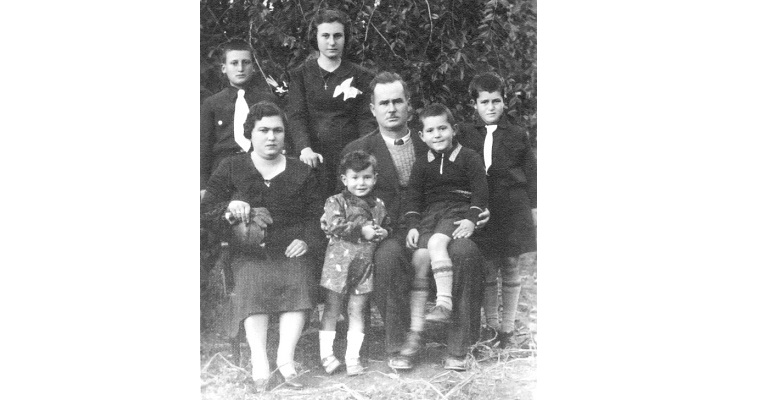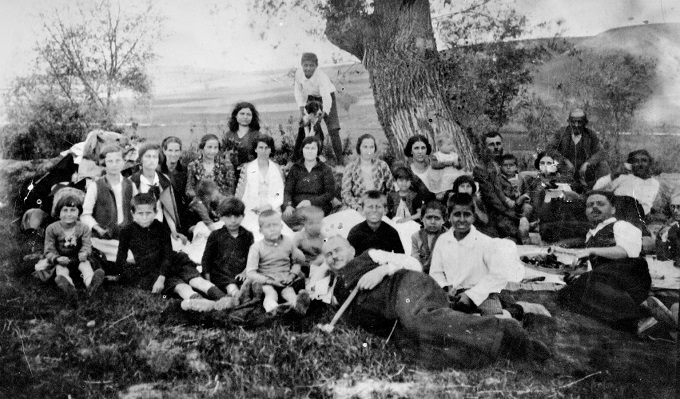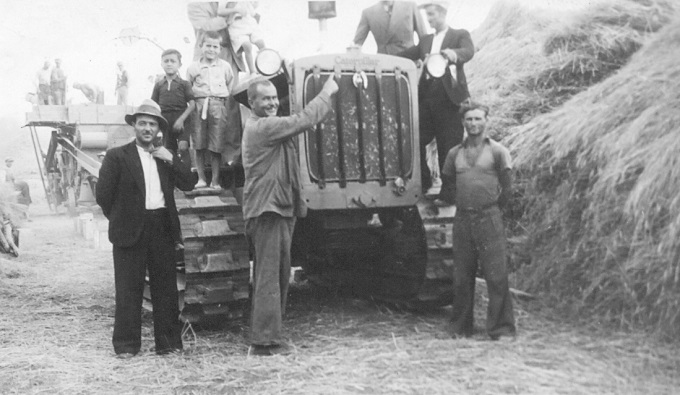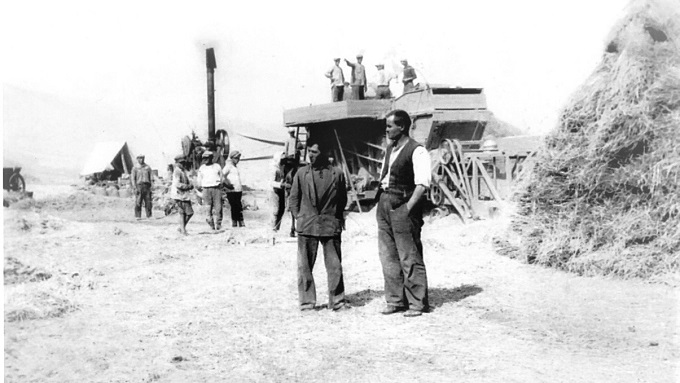
George Nicolaou Pavlidis, c. 1938-39.
George Nicolaou Pavlidis, formerly Pavlioglou (1899-1947) was from Foča (or Phocaea) in Asia Minor. The following testimony was submitted by his granddaughter Miranda Pavlidou via our online questionnaire.
1. From which region of the Ottoman Empire were your ancestors from?:
My grandfather George Pavlidis was born and raised at Phocaea in Asia Minor, north of Smyrna. It's been said that his family was from Mani, Greece.
2. How did their life change when the Neo-Turks and/or the Kemalists came to power? :
Phocaea was one of the wealthiest places in Asia Minor. There were no poor people living there. Life was very pleasant, mixed between the sea and the land, the saltwater and the emery mines, between Old Phocaea and New Phocaea. They lived together in harmony for many years with a small number of Turks who were civil servants there. Suddenly, and without warning on the 12th of June 1914, eight years before the official takeover by Mustafa Kemal, irregular çetes invaded the two villages and began to plunder and destroy whatever they found in front of them. They raped and killed women, slaughtered men and children, looted their wealth and set fire to their homes. Within 24 hours, Greek Phocaea was completely destroyed. On the rooftop of the butcher shop the çetes hung human body pieces of Greeks.
3. Were they deported during the genocide? If so, when, where to, and describe their experience:
The people didn't know what to do. They were unprepared. It caught them napping. I don't know what my ancestors did in the beginning but at some point they found themselves on the waterfront. My grandfather George along with his mother and his two sisters found themselves on a boat called the Karasouli which collected them barefooted and transported them to Thessaloniki, Greece. Inside the ship they were on top of one another. They went without food for days and only had a small amount of water. Women were giving birth. They were in a mess. They couldn't believe what happened; how the possessions that took them centuries to attain had been lost within a few hours.
When they arrived in Thessaloniki, my grandfather was 14 years of age. His sister Anastasia was a little older then him while his sister Sevasti was slightly younger. There, they were initially put in the gardens of Bech Tsinar. Behind this was the old railway station. They stayed in old abandoned train carriages. Slowly they began to settle in to their new environment. They rented a house and managed to survive by serving for the Eastern front's military which had been stationed there during the first World War I.

The family of George Pavlidis. His wife was Maritsa Nikolaidou from Aydin. He met her during the Asia Minor campaign and fell in love with her. Maritsa grew up as an orphan with her grandmother who was a midwife. He later found her in Greece after the exchange, in Rotunda, Thessaloniki and married her immediately. They had five children. In order of birth they were; Panagiota, Nikolaos (back row), Stergios, Phillip and Constantine (baby on lap). The photo was taken around 1938-39.
4. Were they held in a concentration camp or labor camp? If so, where was it located and describe the conditions :
The destruction of Phocaea in 1914 was one of the first in Asia Minor. I've not heard of concentration camps. Only about Greeks fleeing in a disorderly fashion.
5. Did they lose family and friends? If so, how did they cope?:
They lost my grandfather's father Nicolaos and his father's brother Panayioti along with their mother. They were shot at the time they were entering the sea to flee. I also heard about a bedridden old lady who they burnt alive in her home.
They managed to survive thanks to their intelligence and capabilities. My grandfather's mother Maria wasn't a seamstress but she purchased a sewing-machine and made bed sheets for the British military. My grandfather himself assisted the officers. This is how he learned English. When he came of age, he joined the Hellenic Army and was sent to Smyrna. He fought in the Asia Minor campaign. There, he met his friend Konstantinos Adamopoulos and also his wife to-be Maritsa who was from Aydin. He later married her. After the defeat of the Hellenic Army he returned to Thessaloniki and found a job with a French firm that was involved with the exchange of populations between Greece and Turkey. He would load Turks from western Macedonia onto trucks and take them to the port of Volos and from there he would take Greeks and transport them to villages. He searched everywhere for Maritsa at all the refugee camps. It took him three years to find her. He finally found her alone with her grandmother inside the Rotunda in Thessaloniki.

The families of G. Pavlidis and K. Adamopoulos at a picnic. George Pavlidis served with K. Adamopoulos (right, first row) in the Asia Minor campaign where they became very good friends. Later, Adamopoulos married George's sister Sevasti and they became closer. Both of them married and raised five children each. Pavlidis passed away first. Following WW2, Adamopoulos and Pavlidis's younger children were unable to keep their coal mining business going. The photo was taken around 1936-1937.
6. Did anyone within Turkey including Turks try to help them during the genocide? :
They heard small-talk among some Turkish ladies who were their neighbors. It was something like: "You're building the school for no reason. It will become ours." But they didn't really take the talk seriously. Even in coffee houses there was small-talk but again nobody took it seriously. During that period they received many visits from committees of civil servants who recorded their personal assets. That alone should have made them more suspicious. I recently learned about the French archaeologist Félix Sartiaux who raised a French flag on three houses and saved as many Greeks as he could. He is the only foreigner who documented the events with his photographic camera and knew about what happened first hand. I don't know if my ancestors were among those who Sartiaux saved.
7. How did they cope emotionally with their genocide experience? Did it affect the remainder of their life? :
Firstly they changed their name from Pavlioglou to Pavlidis so that it wouldn't sound Turkish. My grandfather's sister Sevasti who was young at the time suffered from severe phobia after the fire at Phocaea. She also lived through the big fire of Thessaloniki in 1917 when her family house was burnt again. A beam fell on her head and left her with a large scar which she lived with her entire life. Whenever she saw a fire she would experience severe bouts of panic.
My grandfather worked himself very hard from a very young age and was full of energy and innovation. He discovered and made a living from brown coal in Ptoleimaida. He founded a company by the name of Brown Coal Mining Proleimaida Pavlidis-Adamapoulos with his brother-in-law Adamopoulos who he served with in Asia Minor and who married his sister Sevasti. They were permanently granted a coal mine comprising 7,441 acres and 560 squares metres at Dorutlar at the site of today's Proasteio. He was the first person to systematically extract brown coal from a mine in Ptolemaida. It was in fact the largest coal mine in the entire region of western Macedonia and provided electricity to all of Greece.
He was fearless and felt very strong. During the occupation of Greece during WW2, the Pavlidis - Adamopoulos coal mines continued operating and fulfilling the needs of the region. The owners took a stand against the enemy motivated by their patriotic feelings. On the 24th of December 1940 the mines were requisitioned by the Hellenic Army and in particular by the commander of the Air Force, Lieutenant Commander E. Kelaidis in order to use the Caterpillar tractor of the company for clearing snow from roads and to assist with the transport of military vehicles. The tractor had arrived direct from the U.S a few months earlier and was considered the only one in the entire Balkans. It helped the Hellenic military in the relocation of a military air base from Kozani to Sedes by opening a road for military vehicles to travel as far as Amindeo. It was later requisitioned by the Germans and was found ruined in the Aliakmona river. Pavlidis worked out a plan to restore the tractor right in front of the eyes of the Germans. Today the tractor is found in the garden of the museum of Ptolemaida. Under his own initiative, Pavlidis voluntarily catered for prisoners of war and as a result the women and children of the neighboring villages of Mesovunio and Pyrgo were saved. The women and children had been transported by the Germans and their accomplices to concentration camps in Ptolemaida in 1941 and also 1944. As a result, in total, he saved approximately 2,500 human lives. The thing that defined him more than anything was his sensitivity to human suffering. He helped many people, voluntarily.

The caterpillar tractor owned by Pavlidis came straight from the U.S just before the war in 1940. It was requisitioned by the Hellenic military for the transfer of the military air base from Kozani to Sedes. It was requisitioned by the Germans and was later found broken down in the river Aliakmon. Pavlidis knew what the problem was and restored it in front of the stunned gaze of the Germans. Because the components of the tractor were sent during the war, they were lost. As a result the tractor wasn't used for the purpose of digging for coal but rather for transporting the harvesting fleet of the company. Today it's located at the museum of Ptolemaida. The photo was taken in Eordaia, Kozani, western Macedonia around 1938.
8. Did the denial of the genocide by the perpetrator (the successor state of Turkey) affect their ability to form closure?:
My grandfather died very young in 1947 at the age of 47. All his children, except my father Nikos, never talked about the trauma that they carried probably because after the war, as orphans, they experienced the downfall of their coal mining business.
We, the 3rd generation, in an attempt to search for ourselves, find ourselves confronted with this trauma and are trying to overcome it by talking about it, by telling our story and making it public. I believe that it has affected all of us not only on a spiritual level but also psychologically, possibly making us more tolerant to to pain and suffering.

In the middle George Pavlidis wearing golf trousers among Greek soldiers on the Albanian front. He fed them and clothed them and reinvigorated them so that they could continue the journey to their destinations. He was a member of the National Resistance movement and gave alot to the struggle for independence. The photo was taken in Ptolemaida around 1941.
9. How did they feel about Turkey after the genocide? :
For them it was always their homeland. It was lost, but it was their one and only home. My grandfather went to fight to free his homeland. Even when everything was lost he amassed wealth in Greece. He believed that if they had returned back, that things for them would have been much better. My grandfather baptized three of his five children with the names of the churches of Old Phocaea.

The first business venture by Pavlidis was a harvesting fleet which was purchased from Thracian refugees around 1924-1925.



